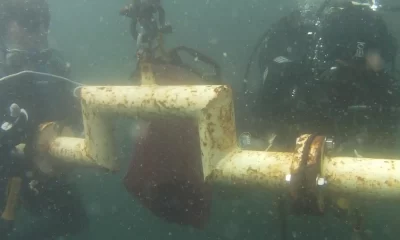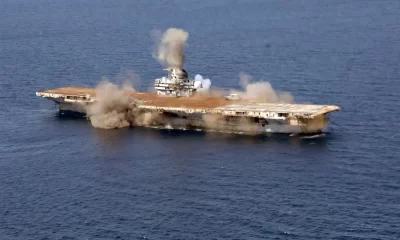Community
Jumping into the Deep End
As you may know, GUE advocates adding helium to your breathing mix when diving beyond 30 m/100 ft. But the recommendation is not just limited to tech divers. Here GUE’s 2019 NextGen scholar and recreational instructor Annika Andresen shares her experience taking GUE’s Rec 3 course, aimed at recreational divers who want to venture a little deeper. In addition to minimizing narcosis, it’s a great way to lighten their load.

by Annika Andresen
Header photo by Kim Hildebrandt
Jumping into the deep end (quite literally!) to kick off my scholarship year and the new decade, the first course I undertook as the NextGen Scholar was the GUE Recreational Diver 3 course (Rec 3). This is a limited decompression course designed to teach advanced diving skills to prepare divers to use decompression cylinders and breathe helium-based gas mixtures. For this course our maximum depth is 40m/130ft. This course was perfect to get me ready for the year ahead, full of diving adventures.
Before the scholarship year, I knew I wanted to do my Technical Diver 1 (Tech 1) and Cave Diver 1 (Cave 1), but in all honesty, I didn’t really know much about the recreational courses. I did my Fundamentals course within my first twenty dives in 2014 and gained my Technical Pass the following year. My scholarship mentor suggested the Rec 3 as a really good stepping stone for Tech 1.
Surface Practice
Day one quickly approached. I excitedly packed my car with all the dive gear I would possibly need and more before heading to meet the team. I was joined by fellow New Zealand (NZ) diver Tyler as he is also using this course in preparation for Tech 1. The NZ diving community is very small which is great because everyone knows each other. We greeted each other with hugs while reminiscing about Christmas before we launched into the jam packed schedule for the next four days.

Photo courtesy of Josh Fretwell.
Like all GUE courses there is both theory and in-water training. Before we jumped into any gear, we went through dry runs with all our equipment—especially how to use a stage bottle for decompression. This was new! I had never used one before and I was interested to see how it was to swim around with an extra bottle attached to the side of me.
On land, it’s a lot easier to go through scenarios and drills when you can talk to each other. Underwater…not so much. You have to rely on what the plan was and how to translate that into hand signals. A hilarious game of charades can arise from those moments of “what?” “huh?” resulting in either a) repeating the signal with more gusto and intensity, or b) amusing facial expression of pure confusion. Fun times ahead!
For the first two days of our course we were joined by Xavier, from the University of Auckland, who is doing his PhD on the effects of inert gas narcosis on our brains while scuba diving. He made a technical subject really easy to understand.
Diving Lake Pupuke
Once our gear was set and were confident in our dry runs, we were ready to head to the lake. Lake Pupuke is a 150,000 year old volcanic crater lake located in Auckland NZ’s North Shore. It is a popular recreational spot especially for dive training, and for the last couple of years it has been monitored by Project Baseline Lake Pupuke. This project has been investigating why the water quality has been deteriorating in the lake and is led by New Zealand GUE diver Ebi, and was a subject of an InDepth article, “Bringing Citizen Science To Lake Pupuke.”

Photo courtesy of PB Lake Pupuke.
The cold, murky waters of Lake Pupuke provided a great training ground for the first two days where we conducted our dives, practiced using our stage bottle, ran through different safety drills and learned how to hold our decompression stops in low visibility. Once we had the nod of approval for our skills in a controlled low visibility environment, we headed north to complete our final two days of diving out in the open ocean at the Poor Knights Islands. These islands lie 50 kilometres to the north-east of Whangarei, New Zealand.
The Poor Knights Islands
With an 8am start, we arrived at Dive! Tutukaka to be greeted by the lovely staff before making our way onto the boat to load our gear. The Poor Knights Islands are protected by a no-take marine reserve with incredibly varied plant, animal, and fish life. The 11-million year old volcanic islands sport a myriad of spectacular drop offs, walls, caves, arches and tunnels. One of the sites at the Poor Knights was ranked in Jacque Cousteau’s top ten dive sites in the world. It’s no secret why I love this place!

Photo courtesy of Dive! Tutukaka, Jack Austin.
It takes under an hour to get to the islands and choose a site for our first dive. This was a big day because if we could plan and execute our dives correctly while responding to the different scenarios given to us, we would be able to dive trimix for our final day!
I led our team’s first dive pre-dive checklist, the so-called GUE EDGE (Goal, Unified Team, Equipment, Exposure, Decompression, Gas, Environment), and made sure everyone knew their roles. I soon realised that my tendency was to lead a dive in a very similar way that I was used to when looking after a group of people. However, these dives were very different in the way your team is positioned and how you ascend/descend to ensure you stay within your plan for your decompression.

Photo courtesy of Kim Hildebrandt.
Debriefing after the dive included some laughs about how relaxed we were during our out-of gas scenario and ascent. Tyler did an excellent job of running the next dive after we discussed what we wanted to improve on. After catching a glimpse of a John Dory (a very delicious NZ fish) and practising more valve failures (very successfully, phew!), our instructor gave us the thumbs up to do trimix dives the next day!
Diving Trimix for the First Time

Photo courtesy Matthew Coutts.
The following morning, we headed out again with Dive! Tutukaka. Our amazing skippers, Chris and Jack, took us to the entrance of the world’s largest sea cave where we started our dive. Our dive plan turned into hysterics when I suddenly spoke with a high-pitched chipmunk voice- forgetting I was on helium. My baby voice kept us amused while being very serious with our instructor looking on having a laugh.
The dive itself was incredible! The visibility in the water was so clear! I loved seeing species that are uncommon in shallower water. I’ve guided this site many times before but I was always diving above 30m/100 ft. It was amazing to see what it was like even if I was only 10m/10ft deeper.

Photo courtesy of Josh Fretwell.
The following dive was even better – exploring a Landing Bay pinnacle that starts at 5m/16 ft and drops down to the sand at 50m/164 ft. We explored some amazing swim-throughs, but the highlights of the day were seeing a white wandering anemone, massive sponges, four long finned boarfish and my favourite—a couple of pairs of Lord Howe coral fish!
Next step…. Tech 1.
Why Recreational Diver 3 Course?
This course is fantastic! I gained so much confidence in gas switching, practicing holding my deco stops while managing failures and an awesome introduction into diving with trimix. I was expecting the course to be similar to my fundamentals course and I personally found it easier.
I am my biggest critic and got frustrated by some of my bad habits that I discovered in my Fundamentals course. When I started the Rec 3, I had only heard of stories about Tech 1 and I thought the course would be much more aggressive. Instead it was the opposite. I was using all the skills I had learnt in my Fundies course and then building on them.
We were never dealing with multiple failures like I had heard about in Tech 1 but learnt how to deal with each failure individually to build a strong foundation for our next courses. After completing my tech pass in the Fundamentals course and Rec 3 (both allow you to progress to Tech 1) I could not recommend Recreational Diver 3 Course more highly. This is a course I felt was essential before starting my Tech 1 course. I feel more prepared and confident to allow me to enjoy my Tech 1 course more.

Photo courtesy of Josh Fretwell.
A HUGE THANK YOU to my amazing instructor, to Xavier for sharing your amazing depth of knowledge and answering all my questions, my team member Tyler for being the best dive buddy and always double checking my math and the team at Dive! Tutukaka, they are all amazing people and the owners Kate and Jeroen are truly incredible. They have always supported me, and I have always admired their passion for protecting our unique and beautiful underwater world.
Dive Deeper:

GUE’s first NEXTGen scholar, Annika Andresen is a virtual reality environmental educator for BLAKE NZ, connecting thousands of young Kiwis with their marine environment. Annika holds a Master of Architecture degree, where her thesis investigated the role architecture plays on the connection people have with their environment. During her studies, Annika worked as a dive instructor for Dive! Tutukaka and was the President of the Auckland University Underwater Club. Annika has just been awarded New Zealand Women of Influence Youth Award for 2019. Using her natural enthusiasm and infectious personality, Annika hopes to educate others to understand and cherish our unique environment to better protect it for the years to come.






















































